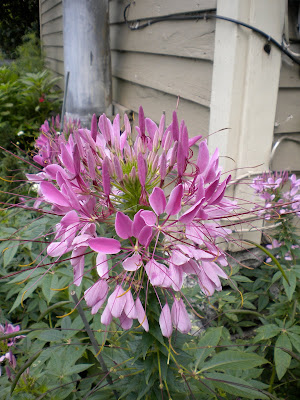


















Nipponanthemum nipponicum
(Montauk Daisy)
This Daisy is a strong, hardy plant that can survive adverse conditions, including drought. It requires little in the way of care, making it a popular plant even with beginner gardeners. There are a few variations on how it got it's name of Montauk Daisy.
After researching it's history I came across this story and it is my favorite:
Posted by Donn of Seaside, New York on Friday, September 24, 2004
'Several years ago, before I moved to Long Island, I used to work in the City, and lived in Queens. I spent untold hours driving to and from Montauk, to surfcast The End.
One night, I was fishing beside an older gentleman who lived in one of the little known small towns, inland (if that's possible) from the coastal towns out there, a town called Springs. He was a retired commercial fisherman, and the fishing was poor, so we chatted through the night, mostly about his fishing career and surfcasting. After sunrise, we were packing up to leave, and he invited me to his house for breakfast, which invitation I gladly accepted.
I followed him west in my van, and we pulled into an oyster shell paved driveway that wound back into a gorgeous landscape of flowers, shrubs and grasses. It seems surfcasting was not his only hobby. He fed me a fish and eggs breakfast, and, with a mug of hot coffee in my hand, he fed me a tour of his gardens.
I won't get into the rest of his landscape, but one bed, snuggled in next to a tiny grove of Beach Plums, jumped out at me. It was approximately 12' in diameter, crudely oval in shape, and both lined and interspersed with beautiful medium sized stones. The only other occupants of the bed were a gorgeous cluster of Montauk Daisies.
I'd seen wild clusters of them along the shoreline from the point back to the village, but I'd never seen them in a garden, and I asked him what they were. He said "They're Montauk Daisies now," with a sneer and a salty look to punctuate his answer.

He went on to tell me that he started the plants that filled the bed with seed gathered from the cliffs along the surfcaster's path. He stuck an envelope into his waders, and slogged up to the plants at the end of their blooming season (which is the height of the fall fishing run), and taught himself how to find and harvest the seeds. The rest is evident in his gorgeous little bed.
This all happened in the 50's, when the villages on the South Fork were not as developed as they are now. In the course of the gentrification of the area, nurseries and landscape professionals moved in, and decided that the ubiquitous Nippon Daisy was an important facet of any locally correct landscape design, but the name was all wrong. They changed it to Montauk Daisy.














The Jerusalem artichoke was titled 'best soup vegetable' in the 2002 Nice festival for the heritage of the French cuisine. Despite its name, this hardy perennial is native of North America. Prepare the vitamin and mineral-rich roots as you would potatoes. Or enjoy their sweet nutty flavor by slicing them raw into a salad or a stir fry.

This perennial grows from 4 – 9’ tall. The tubers are gnarly and uneven, vaguely resembling ginger root, with a crisp texture when raw; they vary in color from pale brown to white, red or purple. The crop yields are high, Jerusalem artichoke also has a great deal of unused potential as a producer of ethanol fuel.




Sedum Autumn Joy – Stonecrop
Drought tolerant perennials flourish well in full sun or light shade. They grow well in poor, dry soils. Zones 3 – 10. One to two feet in height
Their pink flowers turn a rusty red and remain colorful throughout the winter months. They can be increased by division or by rooting leaf or stem cuttings. Butterflies love sedum flowers.
September is the best time to buy plants.
The garden centers need to clear their inventory of summer plants, trees and shrubs to create space for fall and holiday plants, so they reduce prices.
The cooler weather allows plants to expand their roots so it is an excellent time to plant peonies, and low maintenance perennials, such as hostas, daylilies and daisies. Independent nurseries generally have a larger discount than the mega stores. Also, stores like Home Depot, etc., return the unsold plants to the distributer and seldom reduce prices.
September chores for Zones 5 and 6.
Sow perennial and biennial seeds outdoors.
Remove spent blooms.
Prepare soil for fall planting.
Dig, divide and replant iris.
Divide and transplant spring flowering perennials.
Plant poppies and peonies.
*****
I have been very busy this past week gathering seeds from the flowers and making sure that I also gather the seeds from any weeds.
*** If you catch the weed seeds in time it will prevent your garden from being inundated by thousands of unwanted plants in the Springtime :-)





















